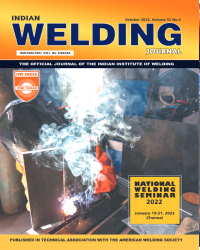On Dissimilar Welding of AISI 304 and EN 8 Steels through Metal Active Gas Welding : Part I-Parametric Optimization Using Taguchi’s Orthogonal Array
Subscribe/Renew Journal
Gas metal arc welding is a flexible technique for joining numerous metallic materials, both similar and dissimilar. AISI 304 stainless steel and EN 8 medium carbon steel plates are welded in this experiment. 100% CO2 gas is used as a shielding gas in this method. Experiments are planned using the Taguchi technique, which employs a three-column, nine-row orthogonal array. This design is chosen based on three welding parameters, each of which has three levels. Heat input, root gap, and torch angle are being used as welding parameters for this investigation. Grey relational analysis approach is utilized for optimization purposes. S/N ratio is calculated for each level of process parameters. Because this experiment aims at maximizing the Grey relational grade (GRG), the best configuration for input parameters is the one with the most significant S/N ratio. Analysis of variance is employed to analyze the significance of input parameters. It is found that sample 9 has the highest GRG of 0.861431. So, the sound weld joint can be obtained at the optimum level where the values of input parameters have heat input of 0.747 kJ/mm, root gap of 2 mm and torch angle of 45°. It is quite challenging to weld dissimilar materials. In this work, a sound weld joint is achieved in between AISI 304 stainless steel and EN 8 medium carbon steel flats, and optimum results are effectively determined.
Keywords
GMAW, MAG Welding, Dissimilar Welding, GRA, Taguchi Analysis, ANOVA.
User
Subscription
Login to verify subscription
Font Size
Information



